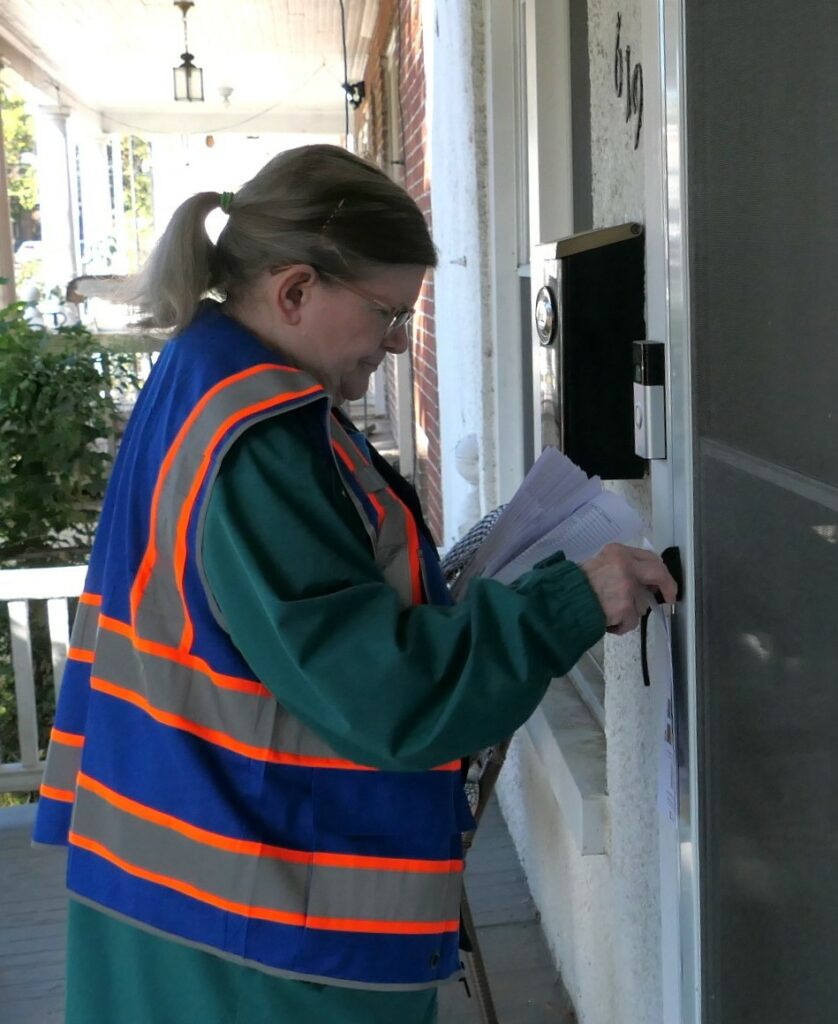City staff and a small group of volunteers from the West Lancaster Jewels fanned out across several blocks in west Lancaster Sunday morning.
Clad in bright blue vests with identification badges, they distributed door hangers with information about lead water pipes. The hangers explain in English and Spanish that the U.S. Environmental Protection Agency is requiring local governments to locate and catalog any and all lead pipes in their water systems — specifically, the “service lines” that connect homes and businesses to water mains.
They invite residents to learn more about the requirement and upload a photo documenting the type of water line they have: Lead, copper, galvanized metal or plastic.

In coming weeks, West Lancaster Jewels volunteers will canvass the neighborhood again. They’ll explain to residents why their water lines need to be documented and how to do it, and will offer to do it themselves if a resident would like them to.
It’s all part of a pilot project that City Hall hopes to expand systemwide.
There are well over 40,000 service lines in the city’s water system, which extends into nine surrounding municipalities. The EPA says the city needs to know what all of them are made of.
Not all of them have to be surveyed — the city can also consult its maps and records — but there are thousands of properties whose status is unknown. Hiring extra staff or a contractor to survey them would be prohibitively expensive.
So, the city is looking instead adopt a grassroots do-it-yourself approach, collaborating with neighborhood groups to get the word out and asking residents to upload the needed information.
Doing it that way will save hundreds of thousands of dollars, Mayor Danene Sorace said, revenue that otherwise would have to be recouped through water rates.
The west side neighborhood was chosen because was next in line on the city’s schedule for lead line abatement.
For more information
Click here to read about the Lancaster water system’s lead service line inventory. Click here to upload information about your water line and complete the city’s survey.
Water systems must complete their inventories by mid-October 2024. Those that serve more than 50,000 people must post them online. (The city’s system serves more than 120,000.) Any water pipes not definitively identified will be presumed to be lead.
Sorace and Public Works Director Stephen Campbell praised the West Lancaster Jewels for their willingness to pitch in. Their results will be tracked to determine the overall response rate. The city hopes it will be high, leaving few or no properties requiring additional action by paid staff or contractors.
The neighborhood group has about 10 volunteers involved in the effort, co-chair Casey Flores said. It conducted similar outreach a few years ago when the city replaced its water meters with ones that can be read remotely.
“We’re feeling pretty confident,” she said.
She and co-chair Miriam Ortega-Brown headed Sunday’s canvassing (which came a day after Ortega-Brown received the city’s Hispanic Heritage Month Lifetime Achievement Award).
The Public Works Department estimates there will be about 140 lead lines to replace in the area the Jewels volunteers covered and is seeking a grant of $872,340 from the Pennsylvania Infrastructure Investment Authority, PennVest, to cover the work. The city originally planned to seek $1.9 million, but recalibrated after learning that none of the grant could be put the grant toward investigative or testing expenses.
The city is providing a $1,500 stipend to the West Lancaster Jewels for its outreach work. That means the money will be reinvested in the community rather than going to a third-party contractor, Director of Neighborhood Engagement Milzy Carrasco said.
Carrasco said her department knows of eight other neighborhood groups it could seek to enlist if the pilot is successful. They, too, would be eligible for stipends, said Christine Volkay-Hilditch, deputy public works director for utilities.
Lead is a health hazard, particularly for small children: Even trace amounts can lead to irreversible brain and nerve damage. The water crisis in Flint, Michigan, dramatically increased concerns over the potential danger from legacy pipes.
The municipal inventories are the first step in a planned nationwide push for lead line replacement. That’s something Lancaster has been doing for years. Last year, Campbell said the city had 550 known lead lines and another 3,200 that may or may not be lead.
Lancaster’s Department of Public Works uses an additive in the system’s water to ensure that lead cannot leach into it. The water is tested continually and “there is no current concern about lead,” the city says.







